Research
Our research focuses on the late and hot stages of stellar evolution, which includes:- Central stars of planetary nebulae
- H-deficient stars
- Close Binaries
- Hot white dwarfs
- White dwarfs showing ultra-high excitation lines
Central stars of planetary nebulae
Planetary nebulae are the expanding, glowing shells of ionized gas ejected from stars late in their lives and are certainly amongst the most beautiful objects in our universe. Their formation is inevitably linked to the evolution of their central stars. The analyses of the central stars offers us the valuable opportunity to understand the various evolutionary path ways of sun-like stars. Since many of them are also found in close binary systems they allow us to investigate the poorly understood common envelope phase and to find possible progenitors of stellar mergers. In rare cases, central stars of planetary nebulae even allow us to witness stellar evolution in real time.
Central star of the Stingray Nebula
The long stellar evolutionary time scales usually make it impossible to watch stars evolving. Our sun, as an example, has hardly changed over the last billion years. A rare exception to this rule is SAO244567 imbedded in the heart of the Stingray Nebula. In 1971 it was still a B-tpye star with a temperature of about 21,000K. But space- and ground-based observations obtained in the early 1990s showed that SAO244567 has heated up rapidly and ionized its nebula within twenty years only.
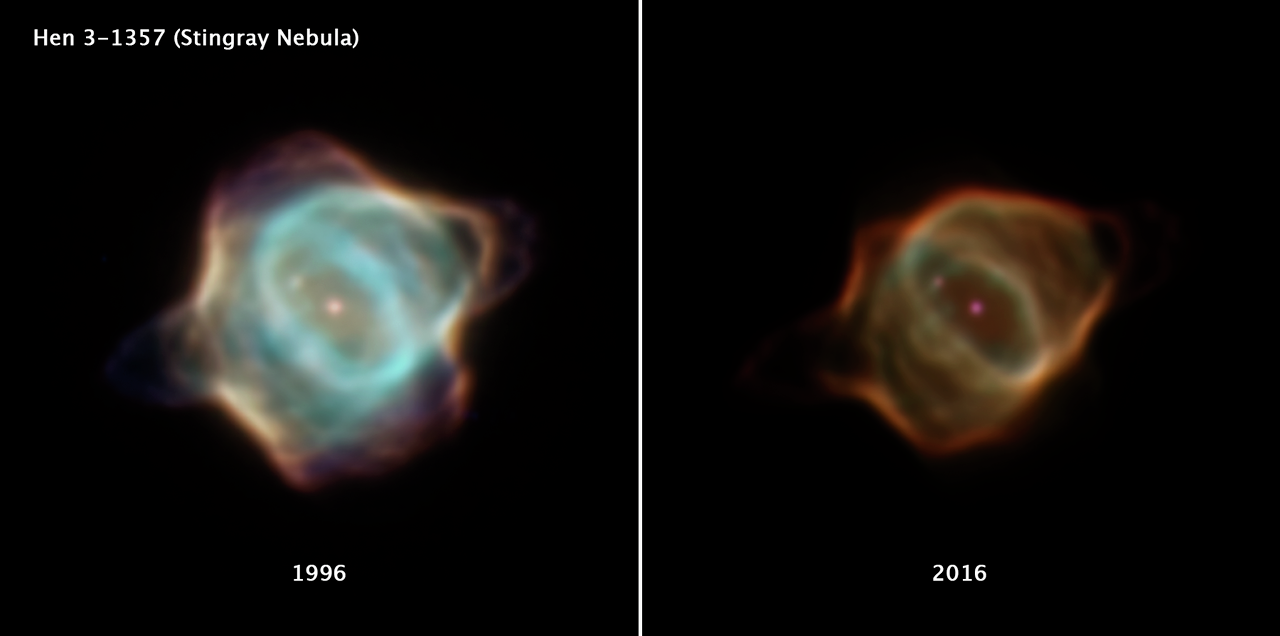
Fading of the Stingray Nebula as captured by the Hubble Space Telescope.
Image credit: NASA, ESA, B. Balick, M. Guerrero, and G. Ramos-Larios
During her PhD N. Reindl addressed the evolution of the properties of SAO 244567 quantitatively for the first time. For that she carried out a comprehensive non-LTE spectral analysis based on archival optical and UV spectra obtained between 1988 and 2006. This analysis showed that the central star has steadily increased its effective temperature from 38,000K in 1988 to a peak value of 60,000K in 2002. During the same time, the star was contracting, the mass-loss rate declined and the terminal wind velocity increased. By comparison with stellar-evolution calculations, we could confirm that SAO 244567 must be a low-mass star (M < 0.55 M☉). However, the slow evolution of the respective stellar evolutionary models is in strong contrast to the observed fast evolution and the young planetary nebula with a kinematical age of only about 1000 years. We speculated that the star could be a late He-shell flash object. A re-ignition of the He-burning shell occurs in about every forth star, once it has left the asymptotic giant branch. It results in an accelerated evolutionary speed and that the star will eventually expand back to giant dimensions.
Publication:N. Reindl, T. Rauch, M. Parthasarathy, K. Werner, J. W. Kruk, W.-R. Hamann, A. Sander and H. Todt: The rapid evolution of the exciting star of the Stingray nebula, 2014, A&A 565, A40, arXiv:1403.6056
Popular science articles can be found here:
Sky and Telescope, Astrobites
New HST/COS observations in 2015
In order to follow the evolution of the surface properties of SAO 244567 and to find out more about its evolutionary history, we applied for further observations with HST/COS. The observations were performed on the 9th of August 2015, more than nine years after the star was observed by an UV telescope for the last time.
These new observations finally allow us to shed light on the evolutionary history of this extraordinary object. Our non-LTE spectral analysis revealed that the star cooled significantly since 2002 and that its envelope is now expanding. Therefore, we conclude that SAO 244567 is currently on its way back towards asymptotic giant branch, exactly what is predicted by late He-shell flash models. The evolutionary speed suggests a central star mass between 0.53 and 0.56 M☉, which corresponds to an initial mass similar to that of our sun.
Publication:
N. Reindl, T. Rauch, M. M. Miller Bertolami, H. Todt, K. Werner: Breaking news from the HST: The central star of the Stingray Nebula is now returning towards the AGB, 2017, MNRAS Letters, 464, L51
Popular science articles can be found here:
Hubble Space Telescope, FOCUS Online, Der Standard, DeMorgen, Pluskosmosu, Sydsvenskan, Gadgetnews, Quo magazine, La Prensa
TOP
H-deficient stars
Canonical stellar evolution predicts that throughout all evolutionary phases stars retain the H-rich envelopes they were born with. Yet, about one out of five intermediate-mass stars turns H-deficient in its late stages of stellar evolution. Over the last decades quantitative spectral analyses of hot (pre-) white dwarfs has revealed a real zoo of H-deficient stars. A well established H-deficient evolutionary sequence is composed of WC type stars central stars that evolve into PG 1159 stars and finally might evolve into H-deficient white dwarfs (spectral types DO, DB, DQ) or H-rich white dwarfs with very thin H envelopes. This sequence is explained by the occurrence of late thermal pulses and has also been observed in real time (e.g., the central star of the Stingray Nebula or Sakurai's object).
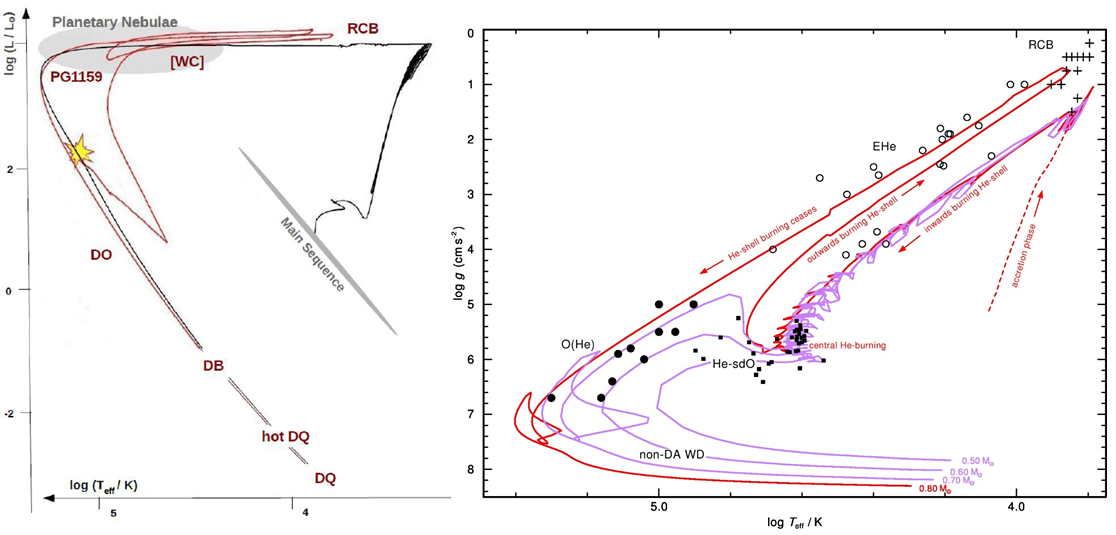
Evolutionary pathways of H-deficient stars. Left: very late thermal pulse scenario in the HRD. Right: Post-merger evolution of two He-core white dwarfs in the Kiel diagram.
In the past years it became clear that a second H-deficient evolutionary channel must exists. In addition to the above mentioned C-dominated sequence, a He-dominated sequence exists, which may contribute to a similar extend to the production of H-deficient white dwarfs like the C-dominated one. The origin of stars with He-dominated atmospheres, such as He-rich subdwarf O stars, R Coronae Borealis stars, extreme helium stars, [WN]-type central stars, and O(He) stars, remains uncertain. Some of them might be the outcome of a double white dwarf merger. The existence of planetary nebulae that do not show helium enrichment around every other O(He) star or [WN]-type central star, however, precludes a merger origin for these stars. In this paper different evolutionary models are discussed in order to explain the origin of the O(He) stars and possible evolutionary links to other helium-dominated stars are made.
With the emergence of large spectroscopic sky surveys, but also by carrying out our own surveys targeting hot (pre-)WDs, more and more fascinating stellar evolutionary paths come to light. Recently, we discovered a H-rich sdB star that is surrounded by a gas disc indicative of a young merger product ( (Vos et al. 2021). We also found a highly magnetic He-sdO, which represents a long sought-after immediate ancestor of strongly magnetic WDs (Dorsch et al. 202)2.
New type of hot subdwarf discovered
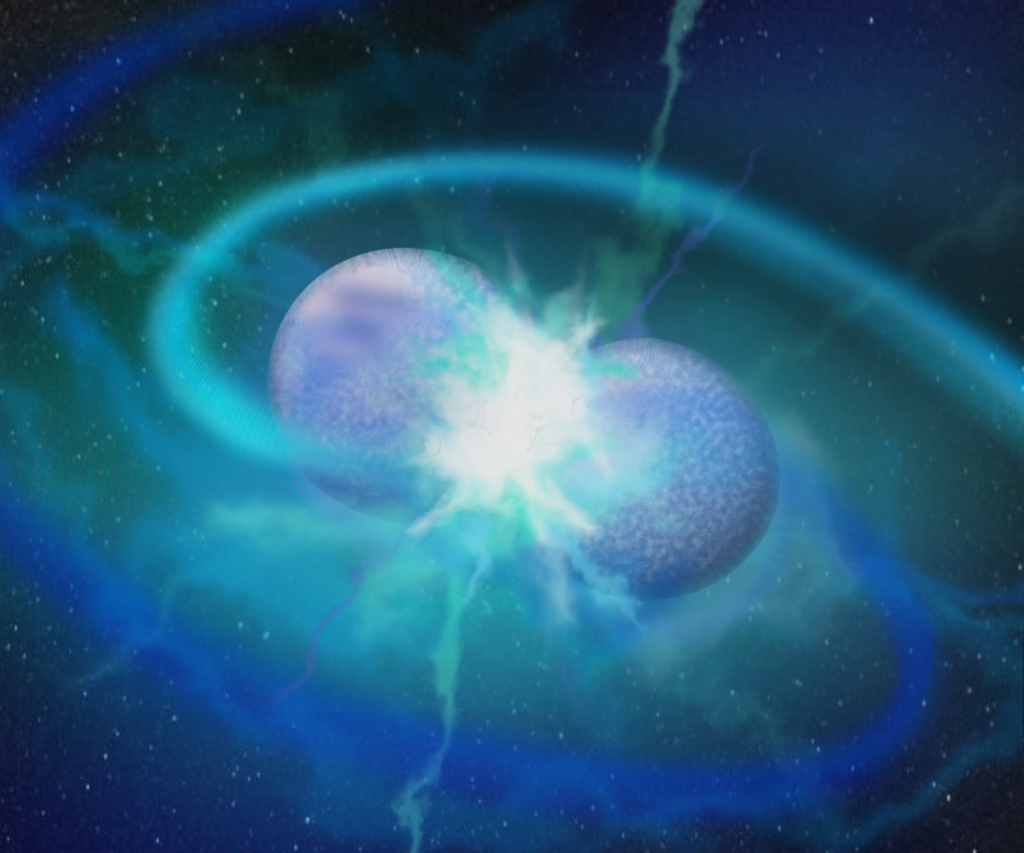
Artist's illustration of a double white dwarf merger.
Image Credit: N. Reindl.
Most recently, we discovered a completely new class of hot subdwarf stars (Werner et al. 2022b). The atmospheres of these so-called CO-sdOs are covered with He-burning ash and are the products of a very rare type of a double WD merger, where a He-core WD accretes a lower mass CO-core WD. Thus, these stars are progenitors of low-luminosity PG1159 stars like RL104 that was also recently discovered by us (Werner et al. 2022a) and proxies for an alternative evolution channel for C-dominant stars.
Press release: Royal Astronomical Society, University of Potsdam, University of TübingenPopular science articles can be found here:
Forbes: Newly Discovered "Freak" Star Challenges Ideas Of Stellar Evolution, Inverse: This rare Frankenstein star wears the skin of its dead companion,
Publications:
K. Werner, N. Reindl, S. Geier & M. Pritzkuleit, 2022, Discovery of hot subdwarfs covered with helium-burning ash, MNRAS Letters, 511, L66
M. Dorsch, N. Reindl, I. Pelisoli, U. Heber, S. Geier, A. G. Istrate, S. Justham, 2022, Discovery of a highly magnetic He-sdO from a double-degenerate binary merger, A&A, 658, L9
K. Werner, N. Reindl, M. Dorsch, S. Geier, U. Munari, R. Raddi, 2021, Non-local thermodynamic equilibrium spectral analysis of five hot, hydrogen-deficient pre-white dwarfs, A&A, 658, A66
M. Uzundag, A. H. Corsico, Alejandro, S.O. Kepler, L. G. Althaus, K. Werner, N. Reindl, K. J. Bell, M. Higgins, G. O. da Rosa, M. Vuckovic, and A. Istrate, 2021, Pulsating hydrogen-deficient white dwarfs and pre-white dwarfs observed with TESS II. Discovery of two new GW Vir stars: TIC333432673 and TIC095332541, A&A, 655, A27
J. Vos, I. Pelisoli, J.Budaj, N. Reindl, V. Schaffenroth, A. Bobrick, S. Geier, J.J. Hermes, P. Nemeth, R. Østensen, J. S. Reding, M. Uzundag, and M. Vuckovic, 2021, Looking into the cradle of the grave: J22564-5910, a young post-merger hot subdwarf? , A&A, 655, A43
N. Reindl, S. Geier, R. H. Østen, 2018, Discovery of two bright DO-type white dwarfs, MNRAS, 480, 1211
N. Reindl, T. Rauch, K. Werner, S.O. Kepler, B.T. Gänsicke, N.P. Gentile Fusillo, 2014, Analysis of cool DO-type white dwarfs from the Sloan Digital Sky Survey data release 10, A&A, 572, A117, arXiv:1410.7666
N. Reindl, T. Rauch, K. Werner, J. W. Kruk and H. Todt, 2014, On helium-dominated stellar evolution: the mysterious role of the O(He)-type stars, A&A, 566, A116, arXiv:1405.1589
Close Binaries
The detection and analysis of compact binary systems is fundamental to various areas of astrophysics. Binary interactions are thought to play a key role in the shaping of planetary nebulae and to be needed to explain the formation of diverse objects, such as white dwarfs with high magnetic fields, some H-deficient stars, extremely low-mass white dwarfs, post-red giant branch central stars of planetary nebulae, or hot subdwarf stars. Compact binaries are crucial to understand common envelope evolution, and they serves as important tests for general relativity as very close binary systems (periods of less than a few hours) emit considerable amounts of gravitational radiation. The emission of gravitational waves in very close white dwarf binary systems shrinks their orbits further and will eventually lead to mass transfer between the white dwarfs or even the merger of the white dwarfs within a Hubble timescale. This can lead to the formation of AM CVn type systems and in some cases even result in type Ia supernovae.
Cuddling inside a nebula - doomed to end in a catastrophe?
The heart of the planetary nebula Henize 2-428 consists of a short
orbital period binary system, with the two stars being actually so
close that they even share a common envelope! Back in 2015, an
article published in Nature claimed a
total mass of the two stars of about 1.8 times that of the Sun,
which is high enough for triggering a supernova type Ia explosion.
Our recent investigations, however, have led to a very different result. By carrying out
a refined wavelength calibration, thorough line-identifications,
improved radial-velocity measurements, non-LTE spectral modeling, as
well as multi-band light-curve fitting, we could show that the total
mass of the system has been significantly overestimated. We find
that the merger of the two stars will not produce a supernova
explosion, but instead will likely give rise to a new star
with a H-deficient atmosphere.
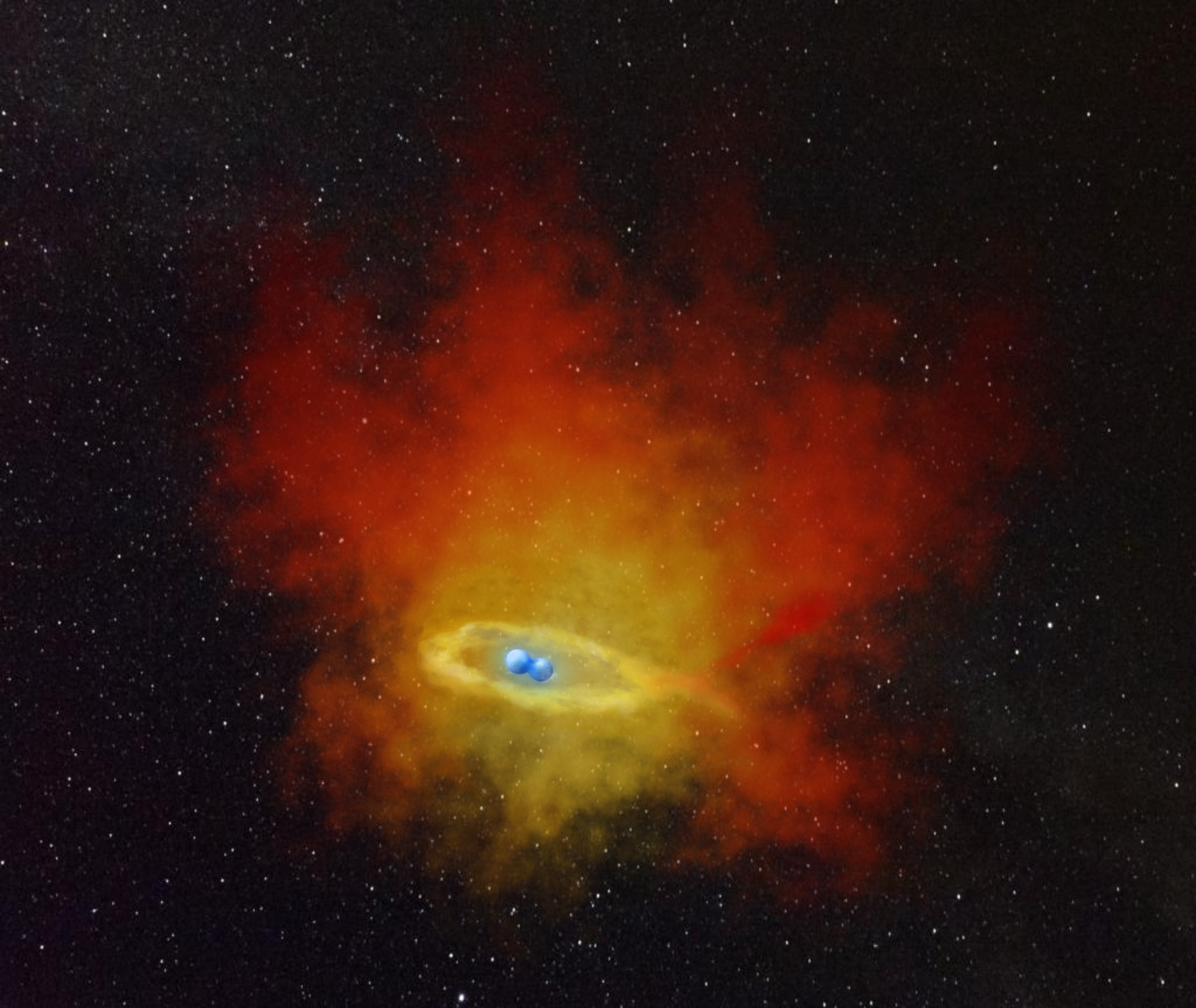
Artist's impression of the two merging central stars inside the planetary nebula Henize 2-428
(Image Credit: Nicole Reindl).
Publications:
T. C. Hillwig, N. Reindl, H. M. Rotter, A. Rengstorf, U. Heber & A. Irrgang, 2022, Two evolved close binary stars: GALEXJ015054.4+310745 and the central star of the planetary nebula Hen 2-84 , MNRAS, 511, 2033
D. Jones, J. Munday, R. L.M. Corradi, P. Rodríguez-Gil, H. M.J. Boffin, J. Zak, P. Sowicka, S. G. Parsons, V. S. Dhillon, S.P. Littlefair, T.R. Marsh, N. Reindl, J. García-Rojas, 2022, The post-common-envelope binary central star of the planetary nebula Ou 5: a doubly-eclipsing post-red-giant-branch system, MNRAS, 510, 3102
N. Reindl, V. Schaffenroth, M. M. Miller Bertolami, S. Geier, N. L. Finch, M. A. Barstow, S. L. Casewell and S. Taubenberger, 2020, An in-depth reanalysis of the alleged type Ia supernova progenitor Henize 2-428, A&A, 638, A93
T. C. Hillwig, D. J. Frew, N. Reindl, H. Rotter, A. Webb & S. Margheim, 2017, Binary Central Stars of Planetary Nebulae Discovered Through Photometric Variability V: The Central Stars of HaTr 7 and ESO 330-9, AJ, 153, 24
N. Reindl, S. Geier, T. Kupfer, S. Bloemen, V. Schaffenroth, U. Heber, B. N. Barlow, R. H. Østensen, 2016, Radial velocity variable, hot post-AGB stars from the MUCHFUSS project - Classification, atmospheric parameters, formation scenarios, A&A 587, A101, arXiv:1601.00874
O. De Marco, J. Long, G. H. Jacoby, T. Hillwig, M. Kronberger, S. B. Howell, N. Reindl and S. Margheim, 2015, Identifying close binary central stars of PN with Kepler, 2015, MNRAS, 448, 3587
Hot white dwarfs
White dwarfs are the most common stellar end products and their study is not only of interest in order to understand the
final stages of stellar and planetary evolution. White dwarfs provide a fossil record of our Milky Way's infancy, possessing
information about our Galaxy's star formation rate as well as the ages of different Galactic populations.
Since the shape of the white dwarf luminosity function quantitatively reflects the cooling behaviour of the white dwarf
population as a whole, it is an excellent tool for constraining the properties of weakly interacting particles emitted by
the white dwarfs.
Large sky surveys, like the SDSS, massively increase the number of known white dwarfs and therefore help to unlock
the enormous scientific potential of these stars. I am actively involved in the discovery of new white dwarfs and
use metal-line blanketing NLTE models to derive the parameters of the hottest white dwarfs.
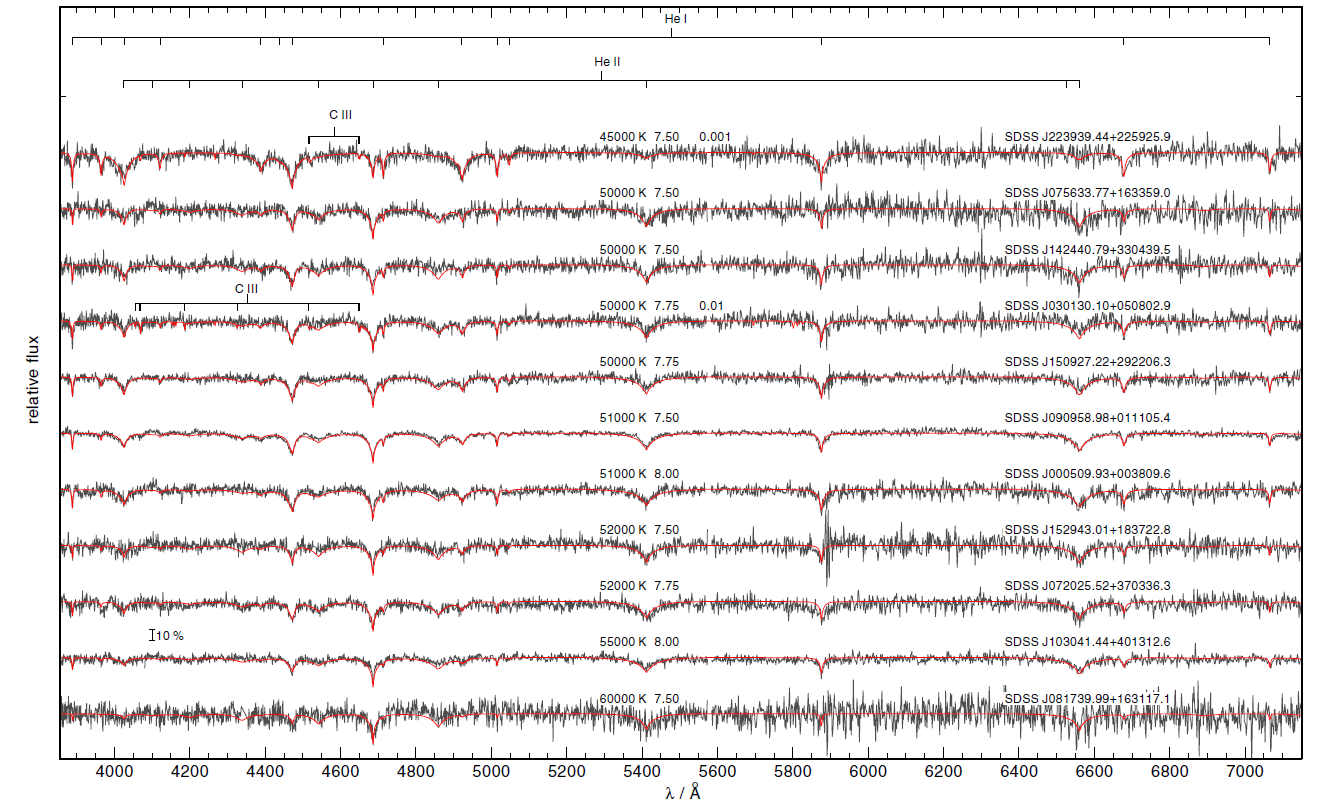
SDSS spectra of DO white dwarfs overplotted with best fit NLTE models (Reindl+2014, A&A, 572, A117).
Lessons from an unlikely couple
Together with Klaus Werner and others
I recently had the opportiunity to learn more about cool stars by
investigating a very unusual system named UCAC2 46706450, and which
consits of white dwarf plus a K-type companion.
Now, what makes this system so special? Firstly, white dwarfs with a F, G, or K-type companion are relatively
rarely known systems in comparison to thousands of M stars with
white dwarf companions. Secondly, the UV source in our system turned out
to be an extremely hot white dwarf with an effective temperature of
105,000K. The K-type star was found to be an even more
exotic object, as it is chromospherically active and one of the most
rapidly rotating sub-giant known. The reason for the rapid rotation in our star remains elusive, though, we speculate
the sub-giant could have formed during a stellar
merger. The study has been published in Astronomy&Astrophysics.

Artist's impression of UCAC2 46706450 (Image Credit: Nicole Reindl).
Testing a gravitational dependency of the fine structure constant
White dwarf stars have recently found a new use in the fundamental
physics community, because they potentially allow us to directly observe variations in
fundamental constants at locations of high gravitational potential.
Many prospective theories of the fundamental interactions of nature allow
traditional constants to vary in some way. In case of the fine structure
constant, α, such a change would result in a small shift in wavelength
centroid of atomic transitions. This effect is larger for metals with more
protons (higher atomic number) and higher ionization energy. Thus, we are using FeV and NiV
lines that can be detected in high-resolution UV spectra of hot white dwarfs to test a gravitational
dependency of the fine structure constant.

Testing a gravitational dependency of the fine structure constant using spectra of hot white dwarfs. Image credit: Julian and Jon Berengut.
SciTechDaily, PhysOrg Publications:
J. Hu, J. K. Webb T. R. Ayres, M. B. Bainbridge, J. D. Barrow, M. A. Barstow, J. C. Berengut, R. F. Carswell, V. Dumont, V. Dzuba, V. V. Flambaum, C. C. Lee, N. Reindl, S. P. Preval, W. Ü. L. Tchang-Brillet, 2021, Measuring the fine structure constant on a white dwarf surface; a detailed analysis of Fe V absorption in G191-B2BP, MNRAS, 500, 1466
K. Werner, N. Reindl, L. Löbling, I. Pelisoli, V. Schaffenroth, A. Rebassa-Mansergas, P. Irawati, J. Ren, 2020, An extremely hot white dwarf with a rapidly rotating K-type subgiant companion: UCAC2 46706450, A&A, 642, A228
S. O. Kepler, I. Pelisoli, D. Koester, N. Reindl, S. Geier, A. D. Romero, G. Ourique, C. de Paula Oliveira, & L. A. Amaral, 2019, White dwarf and subdwarf stars in the Sloan Digital Sky Survey Data Release 14, MNRAS, 486, 2169
S. P. Preval, M. A. Barstow, M. Bainbridge, N. Reindl, T. Ayres, J .B. Holberg, J. D. Barrow, C.C. Lee, J. K. Webb, & J. Hu, 2019, A far-UV survey of three hot, metal-polluted white dwarf stars: WD0455-282, WD0621-376, and WD2211-495, MNRAS, 487, 3470
J. Hu, J. K. Webb, T. R. Ayres, M. B. Bainbridge, J. D. Barrow, M. A. Barstow, J. C. Berengut, R. F. Carswell, V. A. Dzuba, V. V. Flambaum, J. B. Holberg, C. C. Lee, , S. P. Preval, N. Reindl, & W.-Ü LTchang-Brillet, 2019, Constraining the magnetic field on white dwarf surfaces; Zeeman effects and fine structure constant variation, MNRAS, 485,5050
K. Werner, T. Rauch, N. Reindl, 2019, Spectral analysis of the extremely hot DA white dwarf PG0948+534, MNRAS, 483, 5291
N. Reindl, S. Geier, R. H. Østen, 2018, Discovery of two bright DO-type white dwarfs, MNRAS, 480, 1211
M. B. Bainbridge, M. A. Barstow, N. Reindl, G. Nave, W.-Ü. L. Tchang-Brillet, T. R. Ayres, J. K. Webb, J. D. Barrow, J. Hu, J. B. Holberg, S. P. Preval, W. Ubachs, V. A. Dzuba, V. V. Flambaum, V. Dumont & J. C. Berengut, 2017, Probing the Gravitational Dependence of the Fine-Structure Constant from Observations of White Dwarf Stars, Universe, 3, 32
S. O. Kepler, I. Pelisoli, D. Koester, G. Ourique, A. D. Romero, N. Reindl, S. J. Kleinman, D. J.; Eisenstein, A. D. M. Valois, L. A. Amaral, 2016,
New white dwarf and subdwarf stars in the Sloan Digital Sky Survey Data Release 12, MNRAS, 455, 3413
N. Reindl, T. Rauch, K. Werner, S.O. Kepler, B.T. Gänsicke, N.P. Gentile Fusillo, 2014, Analysis of cool DO-type white dwarfs from the Sloan Digital Sky Survey data release 10, A&A, 572, A117, arXiv:1410.7666
White dwarfs showing ultra-high excitation lines
Amongst the hottest white dwarfs there exists a poorly understood - but nevertheless large - group of objects, which I personally like to refer to as the most awkward white dwarfs. Different to ordinary hot white dwarfs, the Balmer or HeII lines of these white dwarfs are unusually deep and broad. The majority of them also exhibits broad absorption features in their optical spectra, identified as Rydberg lines of ultra-high excited (UHE) metals in ionization stages V-X (e.g. OVIII). This is something that has never been observed in any other astrophysical object.
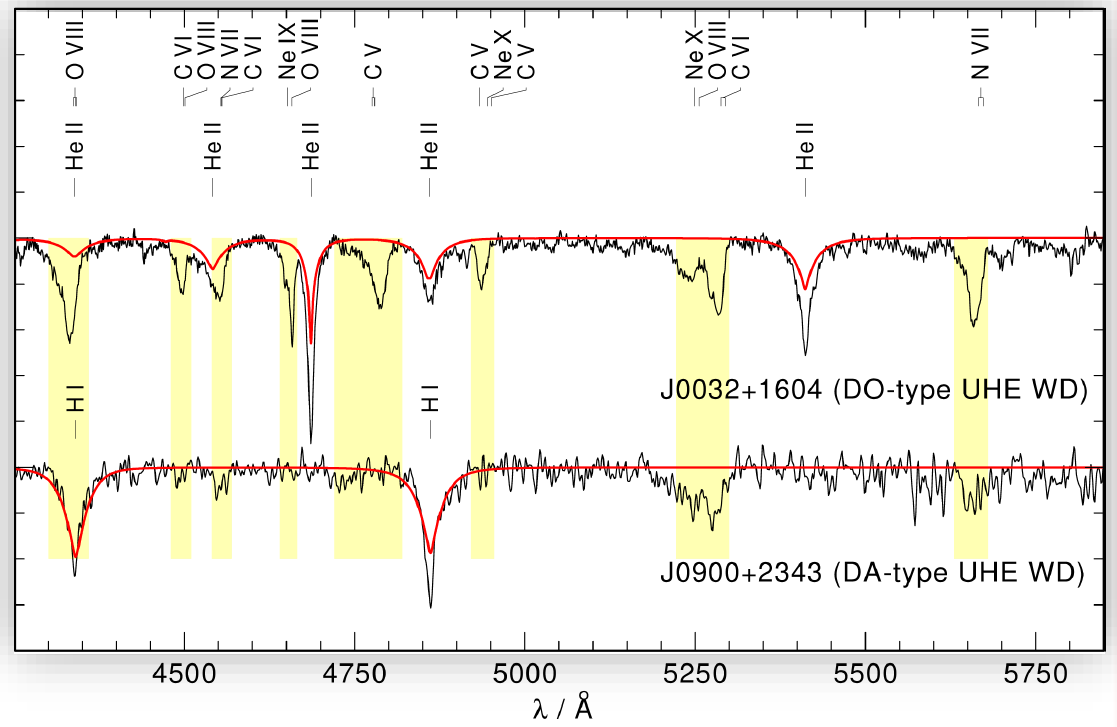
The occurrence of these obscure features requires a dense environment with temperatures of the order 106K, by far exceeding the stellar effective temperature. A photospheric origin can therefore be ruled out. Since some of the UHE lines often exhibit an asymmetric profile shape, it was suggested that those lines might form in a hot, optically thick stellar wind (Werner et al. 1995). The physical process responsible for this suspected extremely hot, optically thick stellar wind, however, posed a decades-long mystery.
GALEXJ014636.8+323615
Recently, we discovered a new hot white dwarf with UHE lines, GALEXJ014636.8+323615, which shows rapid changes of the equivalent widths of the UHE features, which are correlated to the star's rotation period of 5.8 hours. We explain this with the presence of a magnetically controlled, circumstellar plasma in which magnetically confined wind shocks heat up the material to several million Kelvin (Reindl et al. 2019). This could finally offer a plausible explanation of the ultra-hot wind phenomenon and would mark GALEXJ014636.8+323615 as the first white dwarf with a wind-fed circumstellar magnetosphere.
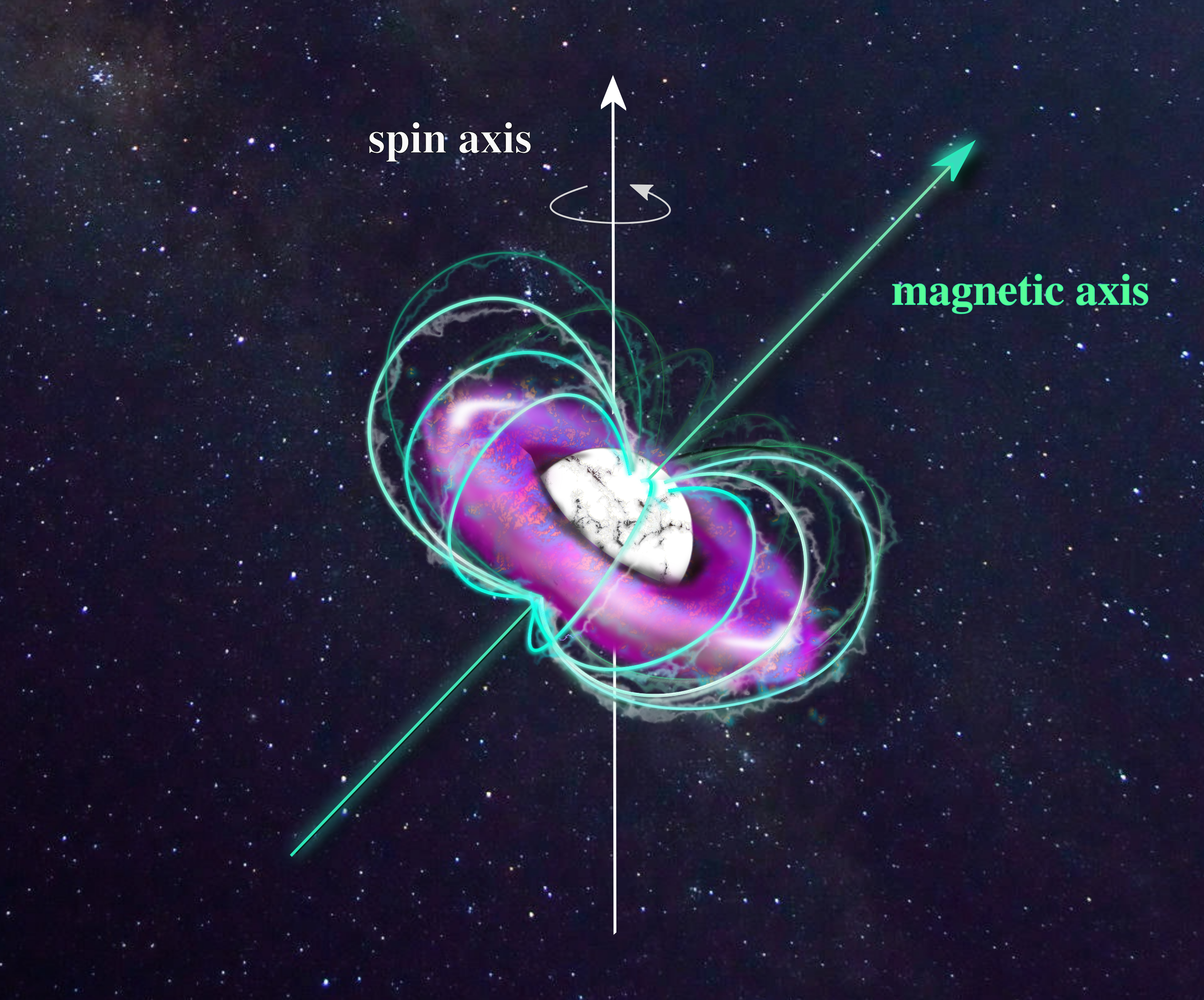
Illustration of GALEXJ014636.8+323615 and its ultra-hot circumstellar magnetosphere. Wind material is trapped within closed magnetic loops and shock-heated. As the star's magnetic axis is tilted with respect to the rotation axis, the brightness and intensity of UHE features vary as the a function of the rotational phase of the system. Image credit: Nicole Reindl.
Variability common amongst UHE white dwarfs
Aiming to gain a better understanding of these mysterious objects, we studied the photometric variability of the whole population of UHE white dwarfs, and white dwarfs showing only the He II line problem, as both phenomena are believed to be connected. We found that 75% of the UHE and He II line problem white dwarfs are significantly photometrically variable, marking them as a new class of variable stars. Our study provided further evidence that UHE and He II line problem white dwarfs are indeed related, as concluded from their overlap in the Gaia HRD, similar photometric variability rates, light-curve shapes and amplitudes, and period distributions. The lack of increasing photometric amplitudes towards longer wavelengths, as well as the nondetection of optical emission lines arising from the highly irradiated face of a hypothetical secondary in the optical spectra of our stars, makes it seem unlikely that an irradiated late-type companion is the origin of the photometric variability. Instead, we believe that spots on the surfaces of these stars and/or geometrical effects of circumstellar material might be responsible.
Publications:
N. Reindl, V. Schaffenroth, S. Filiz, S. Geier, I. Pelisoli, and S. O. Kepler, 2021, Mysterious, Variable, and Extremely Hot: White Dwarfs Showing Ultra-High Excitation Lines I. Photometric Variability, A&A, 647, A184
N. Reindl, M. Bainbridge, N. Przybilla, S. Geier, M. Prvak, J. Krticka, R. H. Østen, J. Telting, K. Werner, 2019, Unravelling the Baffling Mystery of the Ultra-hot Wind Phenomenon in White Dwarfs, MNRAS Letters, 482, L93
S. O. Kepler, I. Pelisoli, D. Koester, N. Reindl, S. Geier, A. D. Romero, G. Ourique, C. de Paula Oliveira, & L. A. Amaral, 2019, White dwarf and subdwarf stars in the Sloan Digital Sky Survey Data Release 14, MNRAS, 486, 2169
N. Reindl, T. Rauch, K. Werner, S.O. Kepler, B.T. Gänsicke, N.P. Gentile Fusillo, 2014, Analysis of cool DO-type white dwarfs from the Sloan Digital Sky Survey data release 10, A&A, 572, A117, arXiv:1410.7666
Popular science articles can be found here:
Astronomy Now, Phys.org, Discover Magazine, Meteoweb, Innovations Report